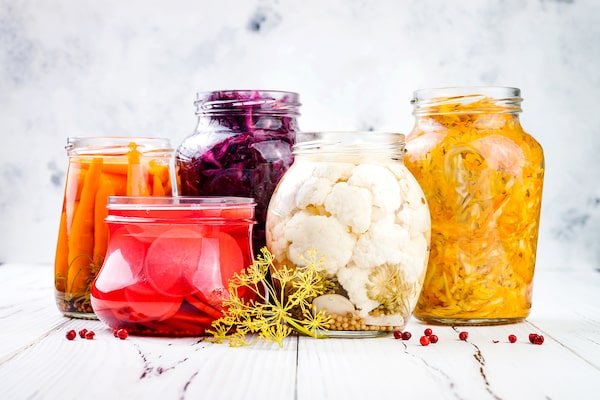
Sauerkraut variety preserving jars. Homemade red cabbage beetroot kraut, turmeric yellow kraut, marinated cauliflower, carrots and radish pickles. Fermented food.sveta_zarzamora
Thirty years ago, my mother made her superb zucchini pickles using a quick pickling method, which no one else bought into back then. Real pickling was (and is) a labour-intensive process – sterilizing jars, canning in water and keeping the finished product for a year on the shelf – but Mum just poured a brine over zucchini and left them in a bowl. She was always ahead of her time.
Today, quick pickles are popping up everywhere. I use them as a condiment because they add acidity and crunch. I toss them into salads, serve them with Indian and Japanese food, snack on them and chop them up as a garnish scattered over barbecued meats and fish. As a soup garnish, they are quite wonderful.
The secret to quick pickling is the ratio of vinegar to water, and the amount of sugar and salt. The more vinegar, the more acidic the pickles. More sugar means a sweeter pickle. As for added spices, there is a whole world out there.
Use fresh unblemished vegetables. Cucumbers are most popular. Buy mini cucumbers, especially the Persian ones. They should be very firm. When pickled, a slightly soft cucumber never has the crunch you want. My favourite pickles are radishes, baby turnips, onions, tiny cherry tomatoes, cauliflower, garlic, ginger, carrots and daikon radish, but you can pickle any vegetable. If I do green beans, I blanch them for a minute then toss them into ice water, so they retain their colour.
I use either rice vinegar or apple cider vinegar as I prefer a mellower taste. White vinegar and wine vinegar work, too, but tend to make for a sharper pickle.
Combine equal amounts of vinegar and water (about 1 cup each) with 1 tbsp Kosher salt and 1 tbsp sugar for about 6 cups vegetables. The sugar is optional, but I prefer to use it. Just remember, the more vinegar, the more acidic the pickles; the more sugar, the sweeter.
The flavourings can change with each batch. My favourites include star anise, togarashi (Japanese peppers), coriander seeds, peppercorns, bay leaves, fennel seeds, cumin seeds, thinly sliced garlic and ginger. Dried chilies or chili flakes add spiciness; herbs to try include dill, tarragon and oregano.
Slice your veggies in the best shape for each – cucumber and radish rounds or carrot batons for example – and place them in a big bowl. Bring your pickling liquid to a boil for 2 minutes, and then pour it over the vegetables. If they are not quite covered, press them down a little. Leave on the counter to cool. When cold, store as I do in a big glass container or in glass jars in the fridge.
If you are giving them away, write on the label that they should be kept refrigerated. They last a couple of months, although a week is about my record.
Need some advice about kitchen life and entertaining? Send your questions to lwaverman@globeandmail.com.
 Lucy Waverman
Lucy Waverman